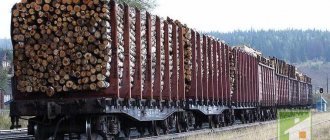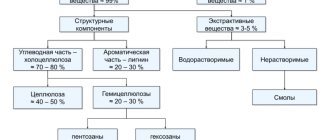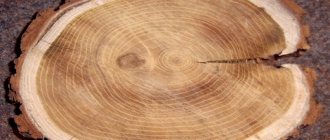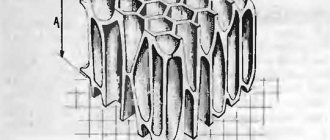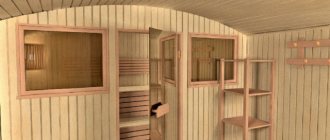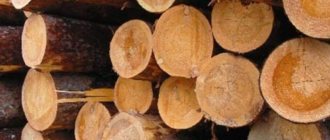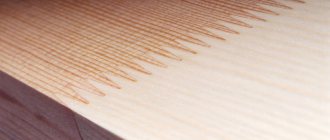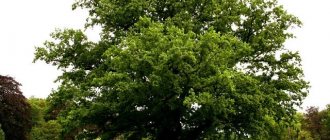Natural wood has attractive qualities. These are low thermal conductivity, maintaining an optimal level of humidity, fast heating and maintaining a comfortable indoor climate. Furniture is made from wood and used for heating purposes. This happens due to the unique characteristics and properties of wood.
Basic properties and characteristics of wood
The properties of wood can be divided into four types:
- physical. They are characterized by density, weight, permeability and ability to resist aggressive influences of the external operating environment;
- chemical ones are characterized by indicators of resistance to the action of chemical reagents that contribute to the destruction of the material;
- mechanical properties are assessed by the ability to resist compression and tension. Resistant to impacts and other types of force;
- technological properties indicate the ability of wood to hold fasteners.
Based on these properties, the scope of their application is determined. When considering wood taking into account the complex of all characteristics, it is clearly clear that it has no competitors.
Density and Density Ratio
Each type of wood has a different density coefficient. It depends on the moisture content of the wood. The density of wood represents the bulk density. For approximate calculations, you can use a special table.
Average densities of different wood species
| Tree species | Density kg/m3 (at 12% humidity) |
| Spruce | 445 |
| Fir | 375 |
| Birch | 650 |
| Larch | 660 |
| Pine | 500 |
| Ash | 680 |
| Hornbeam | 800 |
| Oak | 690 |
Wood structure
There are two concepts: “tree” and “timber”. A living, growing tree consists of a root, a trunk and branches with leaves or needles.
Wood is the fabric of a tree, it is obtained by sawing its parts. The trunk provides the bulk of the wood. It is divided into apex and butt.
The tree is protected by a bark consisting of rind, cork fabric and a bast layer. Beneath it there is a ring layer - the cambium. When cutting the tree, the rings are clearly visible. They are used to calculate the age of the tree.
In the center is the core. It is loose and soft. Rays emanate from the core. Along these rays, wood can crack when drying.
Around the core there is mature wood. It has great strength.
The wood closest to the bark is called sapwood. It is less durable, has high humidity, has severe shrinkage and warps.
What wood is made of is clearly shown in the picture.
Chemical composition
Dry wood consists of carbon, oxygen and hydrogen, from which complex organic substances are formed:
- Cellulose. This very stable substance is insoluble in water and organic solvents. Many different materials are made from it: paper, cotton wool, cellophane, varnishes, artificial fibers, gunpowder and other materials.
- Lignin and hemicellulose are polymers of aromatic nature. Ethyl alcohol, dry ice, feed yeast, and vanillin are obtained from them.
- The rest of the composition is tannins and resins.
Color
The color of wood is important when choosing a material for making furniture, in the production of artistic crafts, and for interior decoration. Wood has a wide variety of colors and shades. Even one board can combine several colors. The color intensity may increase as the tree ages. A change in color indicates wood rotting or fungal infection.
The color of wood can be easily determined using a color atlas. You can also use visual and photoelectric colorimeters.
Example of a wood color catalog
Natural humidity
For wood of various species, natural humidity ranges from 23 to 35%. The humidity indicators of pine that grew in a dry place and spruce that grew in a wetland are very different.
Humidity is measured using:
- electric moisture meter. This special device has metal sensors with sharp ends. Their tips are pierced into the sample under study, after which the current is turned on. You can see the result on the instrument scale.
- Nomogram. They give more accurate results.
- By weighing. To do this, take a sample of wood, dry it and weigh it.
In addition to drying, water can be removed by pressing.
Boards made from damp wood will begin to warp. Therefore, for building a house it is allowed to use wood with a moisture content of no more than 12% -15%. This is a standard indicator that is included in building codes.
- 1. Color, shine and texture of wood
- 2. Wood moisture content and properties associated with its change
- 3. Density of wood. Thermal properties of wood
- 4. Electrical and acoustic properties of wood
- 5. Durability of wood
- 6. Technological properties of wood
LECTURE No. 4. Properties of wood
1. Color, shine and texture of wood
Color
wood depends on the climatic conditions of the tree's growth. In temperate climates, wood of almost all species is pale in color, but in tropical climates it is brightly colored. The influence of the climatic factor also affects within one zone, for example, species growing in warmer zones - oak, walnut, yew and others - have an intense color, while those growing to the north - spruce, pine, aspen, birch and others - are pale in color. The intensity of color also depends on the age of the trees - with increasing age, the intensity increases. Wood color changes under the influence of air and light, as well as from the effects of fungal infections; when aging wood in water or special solutions; during steaming and high-temperature drying.
The color of wood is an important characteristic and is taken into account when choosing species for making furniture, interior decoration, in the production of artistic crafts, musical instruments, etc.
Shine
– this is the ability of wood to reflect light flux directionally. Smooth mirror surfaces have the greatest shine, as they give directional reflection. As a rule, the gloss of wood is assessed by its whiteness: the greater the whiteness of the wood, the higher the gloss value. Glare and reflections are also produced by core rays in radial sections.
Texture
- this is a natural pattern on tangential and radial sections of wood, formed by annual layers and anatomical elements. The more complex the structure of wood, the richer its texture. Coniferous wood has a simple structure and uniform texture, it is determined mainly by the width of the growth rings and the difference
colors of early and late wood. Hardwood has a complex structure and richer texture. The nature of the texture largely depends on the direction of the cut. Many species, such as walnut, ash, elm, oak and others, have a beautiful and interesting texture when viewed tangentially. The wood in the radial cut also has a beautiful, original texture.
The wood of burls, formed on the trunks of deciduous trees, has high decorative properties. The “bird’s eye” texture of maple wood is very original, created by “sleeping” buds that have not developed into shoots. A unique and beautiful texture is also created artificially by uneven pressing of wood and its subsequent planing, or by peeling with a wavy knife, or at an angle to the direction of the fibers. With a transparent wood finish, its texture is more pronounced. Texture is the most important indicator that determines the decorative value of wood.
Types of wood texture:
1) without a pronounced pattern - linden, pear;
2) finely speckled pattern - oak, beech, plane tree;
3) moire pattern - gray maple, wavy birch, mahogany;
4) bird's eye pattern - ash, maple, Karelian birch, Ukrainian poplar;
5) shell pattern – Caucasian walnut, ash, elm – butt part;
6) knotty pattern - spruce, pine.
2. Wood moisture content and properties associated with its change
Freshly cut wood, as a rule, contains a large amount of water and in the future, depending on storage conditions, it can increase or decrease, or remain at the same level. But in most cases it is necessary to take measures to remove water, that is, dry the wood. An indicator of the water content in wood is humidity, which is divided into absolute and relative. In practice, they mainly use abso
the absolute value of humidity, which is determined by the formula:
Wabs. = [(m – m0) / m0] ? 100 %,
where m
– mass of wet wood sample, g;
m0
– mass of the same absolutely dry sample, g. The relative humidity indicator is rarely used, mainly as an indicator of the moisture content of firewood. It is determined by the formula:
Wrel. = (m – m0 / m) ? 100 %.
There are two ways to determine humidity - direct and indirect. The direct method is based on the extraction of water from wood. To do this, the cleaned wood sample is dried in an oven at a temperature of 103 °C until the moisture is completely released. During the drying process, the sample is weighed - the first time 6-10 hours after the start of drying, and then every 2 hours. Drying is stopped after the weight of the sample no longer decreases. The direct method allows you to determine the moisture content of wood with great accuracy.
The second method is indirect, based on measuring the electrical conductivity of wood using an electric moisture meter. With this measurement, the instrument scale shows the humidity value. This method makes it possible to quickly determine humidity. But its disadvantage lies in the measurement error, which is 2–3%, and even higher if the wood moisture content is more than 30%.
Water in wood is in a bound and free state. Bound water is found in the cell walls and is held firmly. Removing such water is difficult and has a significant impact on changing most of the properties of wood. The maximum amount of bound water corresponds to the saturation limit of cell walls, which is accepted in calculations: Wp.n. = 30%.
Free water is found in cell cavities and intercellular spaces, so it is easier to remove from wood.
Freshly cut wood has a moisture content in the range of 50-100%, and when left in water for a long time - more than 100%.
After drying in the open air, the humidity is reduced to 15–20%. Humidity of 20–22% is called transport humidity,
and the moisture content that wood has during operation is
operational.
There are two types of wood drying - atmospheric,
at ambient, and
artificial,
or chamber temperatures, when the temperature can be up to 100 °C and higher. During chamber drying, wood shrinks, i.e., a decrease in linear dimensions in the radial direction by 3–7%, and in the tangential direction by 8–10%, along the fibers by 0.1–0.3%. Total volumetric shrinkage is 11–17%.
When drying wood with decreasing humidity, its mechanical properties change - elasticity decreases, but compressive strength increases, and electrical conductivity decreases.
3. Density of wood. Thermal properties of wood
Wood Density
is the mass of a unit volume of material, expressed in g/cm3 or kg/m3. There are several indicators of wood density that depend on humidity. The density of woody matter is the mass per unit volume of the material that forms the cell walls. It is approximately the same for all rocks and equal to 1.53 g/cm 3, i.e. 1.5 times higher than the density of water.
The density of absolutely dry wood is the mass per unit volume of wood in the absence of water. It is determined by the formula:
?0 = m0 / V0,
where p0 is the density of absolutely dry wood, g/cm3 or kg/m3;
m0
– mass of wood sample at 0% humidity, g or kg;
V 0
– volume of wood sample at 0% humidity, cm 3 or m 3.
The density of wood is less than the density of wood substance, since it has voids filled with air, i.e. porosity, which is expressed as a percentage and characterizes the ratio of voids in absolutely dry wood. The higher the density of wood, the lower its porosity.
The density of wood depends significantly on humidity. With increasing humidity, the density of wood increases. By density, all species are divided into three groups (with a wood moisture content of 12%):
1) species with low density - 540 kg/m3 or less - these are spruce, pine, linden, etc.;
2) medium-density species - from 550 to 740 kg/m3 - oak, birch, elm, etc.;
3) high-density species - 750 kg/m3 or more - dogwood, hornbeam, pistachio, etc.
Thermal properties of wood
are heat capacity, thermal conductivity, thermal diffusivity and thermal expansion. Heat capacity is the ability of wood to accumulate heat. The specific heat capacity C is taken as an indicator of heat capacity - the amount of heat required to heat 1 kg of wood mass by 1 °C. Is it measured in kJ/kg? t °С.
Dry wood consists of woody matter and air, and the mass fraction of air in it is insignificant. Therefore, the heat capacity of dry wood is almost equal to the heat capacity of woody matter. The specific heat capacity of wood is practically independent of the species and at a temperature of 0 °C for absolutely dry wood it is equal to 1.55 kJ. With increasing temperature, the specific heat capacity increases slightly and at a temperature of 100 °C it increases by approximately 25%. When wood is moistened, its heat capacity increases.
The process of heat transfer in wood is characterized by two indicators - the thermal conductivity coefficient and the thermal diffusivity coefficient. Coefficient of thermal conductivity? numerically equal to the amount of heat that passes per unit time through a wall of wood with an area of 1 m2 and a thickness of 1 m with a temperature difference on opposite sides of the wall of 1 °C. It is measured in W/(m? °C).
The thermal diffusivity coefficient characterizes the rate of change in the temperature of wood when it is heated or cooled. It determines the thermal inertia of wood, i.e. its ability to equalize temperature. The thermal diffusivity coefficient is calculated using the formula:
? = ?/s ? ?,
Where ? – material density, kg/m3;
? – thermal conductivity coefficient, W / (m ? °C);
c – specific heat capacity of wood, kJ / (kg ? °C).
4. Electrical and acoustic properties of wood
As numerous studies of the electrical properties of wood have shown, its electrical conductivity, i.e., its ability to conduct electric current, is inversely related to its electrical resistance. There are surface and volume resistances, which together give the total resistance of a wood sample placed between two electrodes. Volume resistance characterizes the obstacle to the passage of current through the thickness of the sample, and surface resistance - along the surface. Indicators of electrical resistance are specific volumetric and specific surface resistance.
Studies have shown that dry wood conducts electricity poorly, but its resistance decreases with increasing humidity. This can be seen from the data obtained during the studies (Table 1).
Table 1
A decrease in surface resistance occurs with increasing humidity. For example, when the moisture content of beech increases from 4.5 to 17%, the surface electrical resistance decreases from 1.2? 1013 to 1 ? 107 Ohm.
In addition, as a result of research, it has been established that a decrease in the electrical resistance of wood occurs when it is heated, especially when its humidity is low. Thus, an increase in temperature from 20 to 94 ° C reduces the resistance of absolutely dry wood by 10 6 times.
Acoustic properties.
When studying the acoustic properties of wood, it was found that the speed of sound propagation in wood is greater, the lower its density and the higher its elastic modulus. The average values of sound speed along the fibers for room-dry wood are: oak - 4720 m/s, ash - 4730 m/s, pine - 5360 m/s, larch - 4930 m/s. Further studies have shown that the speed of sound across the fibers is 3–4 times less than along the fibers. The speed of sound propagation depends on the properties of materials and, first of all, on density, for example, in steel, sound travels at a speed of 5050 m/s, in air - 330 m/s, and in rubber - 30 m/s. Based on data obtained from studies of the acoustic properties of wood, an ultrasonic method was built to determine its strength and internal hidden defects. According to existing building codes, the sound insulation of walls and partitions should be at least 40, and between floors - 48 dB. According to research data, the sound absorption capacity of wood is low, for example, the sound insulation of pine wood with a thickness of 3 cm is 12 dB, and oak wood with a thickness of 4.5 cm is 27 dB. As research has established, spruce, fir and cedar wood has the best acoustic properties in terms of the greatest sound emission, which is used for the manufacture of many musical instruments: plucked, bowed, keyboards, etc. As practice has shown, long-seasoned wood has the best acoustic properties - for 50 years or more.
5. Durability of wood
Mechanical properties include the strength and deformability of wood, as well as some technological properties. The strength of wood is its ability to resist destruction under the influence of external loads. The tensile strength of wood is determined by testing samples for compression, tension, bending, and shear.
When testing wood for compression, the load is applied along the fibers, then across and in one place. The tensile strength is determined in MPa using the formula:
bszh = Pmax / a? b,
where Pmax is the maximum breaking load, N;
A
and
b
– dimensions of the wood sample, mm.
Test data have shown that when wood is stretched across the grain, the strength is approximately 1/20 of the tensile strength along the grain. Therefore, when designing products and constructing various building structures, do not allow tensile loads to be directed across the fibers.
In practice, in most cases, wood products work with bending loads. Therefore, wood samples must be tested for bending, and the tensile strength in MPa is determined using the formula:
biz = 3Рmax ? l/2 ? b? h2,
where l is the distance between supports, mm;
b
– sample width in the radial direction, mm;
h
– height of the sample in the tangential direction, mm.
When a sample is bent, tensile stresses arise on the convex side, and compression stresses arise on the concave side. At loads above the maximum value, wood destruction occurs in the form of rupture of stretched fibers on the convex side of the sample fracture.
Shear strength is of great importance. This indicator is determined by testing three types of shear: chipping along and across the fibers; for cutting wood across the grain. In this case, the tensile strength of wood for chipping - bsk, MPa is determined by the formula:
bsk = Pmax / b ? l,
where P max – maximum load, N;
b, l
– thickness and length of the sample in the shear plane, mm. Tests for cutting wood across the grain are carried out on samples using a moving knife. In this case, the tensile strength in MPa is determined by the formula:
? = Рmax/2? a? b,
where Pmax – maximum load, N;
A
and
b
– cross-sectional dimensions of the sample, mm (transverse). Test results show that the strength of wood when cut across the grain is 4 times greater than when chipped along the grain.
As tests have shown, the modulus of elasticity in compression and tension of wood is approximately the same and amounts to 12.3 GPa for pine, 14.6 GPa for oak and 16.4 GPa for birch at a humidity of 12%. The elastic modulus across the fibers is approximately 20–25 times less than along it, and in the radial direction it is higher than in the tangential direction, by approximately 20–50%.
When testing wood, the elastic modulus is also determined:
E = 3? R ? l/(64b ? h3 ? f),
where P
– load equal to the difference between the upper and lower limits of measurement, N;
l
– distance between supports (on which the wood sample is located), mm;
b
and
h
– width and height of the sample, mm;
f—
deflection equal to the difference between the arithmetic mean values of deflection at the upper and lower loading limits, mm.
6. Technological properties of wood
Technological properties: impact strength, hardness, wear resistance, ability to hold screws, nails and other fasteners, as well as machinability with cutting tools.
Impact strength of wood
- this is its ability to absorb forces (work) upon impact without destruction. The greater the amount of work required to fracture the sample, the higher its viscosity. Impact strength is determined by the formula:
A
=
Q/b x h,
J/cm 2,
where Q
– work spent on breaking the sample, J;
b
and
h
are the width and height of the sample.
Wood hardness
- this is its ability to resist the indentation of a body made of a harder material - a steel punch with a hemispherical tip with a radius of
r
= = 5.64 mm to a depth of 5.64 mm. In this case, at the end of the loading, the load P is counted on the machine’s force meter scale. After the test, an imprint with an area of 100 mm 2 remains in the wood. The static hardness of the sample is determined in N/mm using the formula:
N = P / ? ? r2,
Where ? ? r2
r
is pressed into it mm.
If the samples split during testing, the punch is pressed to a shallower depth - 2.82 mm, and the hardness is determined by the formula:
Н = 4Р/(3? ? r2).
All rocks are divided into three groups according to the hardness of the end surface: soft - with a hardness of 40 N/mm2 and less, hard - 41–80 N/mm2 and very hard - more than 80 N/mm2.
Wear resistance
wood is characterized by its ability to resist wear due to friction against the surface of abrasive elements or microroughnesses of a harder body.
When testing for abrasion, conditions are created that simulate the actual process of abrasion of wood used for floors, stairs, and decking. Abrasion is carried out on a special machine. In this case, the abrasion index t
is calculated in mm using the formula:
t = h? (m1 – m2) / m1,
where h
– sample height before abrasion, mm;
m
1
and
m 2
– sample mass before and after testing, respectively, g.
The specific resistance to pulling out a nail or screw is determined by the formula:
Rud. = Pmax / l (N/mm),
where Pmax is the maximum load when pulling out nails or screws;
l
– length of driving a nail or screwing in a screw. The ability of wood to hold fasteners depends on its species, density and humidity. The pullout resistance of nails driven in the radial and tangential directions is approximately the same, but it is higher than when driving nails into the end of the sample.
Ability of wood to bend
– the best for beech, oak, ash, worse – for coniferous species. To improve the pliability of wood, it is steamed before bending, then after bending it is cooled and dried in a fixed state, as a result of which it acquires a stable curved shape.
Ability of wood to split
- this is the process of separating it along the fibers under the influence of a load transmitted to the wedge. This is a negative property of wood when driving nails close to the edge, as well as spikes and screws when screwing in, but a positive property when chopping firewood or preparing split logs.
Table of contents
Wood cube weight
The weight of wood is a distinctive feature of the species. For ease of calculations, use the online cubeturner. This is a special table with a built-in calculation mechanism. To find out the weight of a tree, you need to enter its species, humidity and indicate the required amount of wood in cubic meters. The built-in mechanism will calculate the weight.
Specific and volumetric gravity
The specific gravity of wood is taken into account without moisture and air. This is a very unstable value. It is calculated using a special table. In practice, the volumetric weight of wood is more often used. It is measured in kilograms of weight per cubic meter. This weight is taken into account with the air and water contained in the wood. Volumetric weight indicators are constantly changing and must be taken into account when processing wood waste.
Elastic modulus
Elastic moduli are important design quantities. They characterize the rigidity of a material and its ability to change shape under the influence of mechanical resistance. Determining the elastic modulus is very difficult; this requires ultra-precise instruments.
Design bending resistance
The calculated resistance of wood is measured in kg/cm?. These parameters must be known when designing wooden structures. They have different values under different loads. The calculated resistances take into account the reduction in wood strength.
Strength
Strength indicates the ability of wood to resist destruction under loads. Strength tests are carried out using standard methods on wood samples that do not have defects. When carrying out tests, the effects of forces on tension, bending, compression and shearing are revealed.
Indicators of compressive strength of various types of wood
| Breed | Ultimate compressive strength along the fibers, MPa | Ultimate compressive strength along the fibers, MPa |
| At humidity, % | 12 | 30 or more |
| Larch | 64,5 | 25,5 |
| Pine | 48,5 | 21,0 |
| Spruce | 44,5 | 19,5 |
| Cedar | 42,0 | 18,5 |
| Siberian fir | 39,0 | 17,5 |
| White acacia | 77,5 | 41,5 |
| Hornbeam | 60,0 | 26,5 |
| Maple | 59,5 | 28,0 |
| Ash | 59,0 | 32,5 |
Brinell hardness
In our country, the hardness of wood is indicated on the Brinell scale. The hardness of wood is characterized by its ability to resist the penetration of a solid body. The higher the hardness, the more difficult the processing.
To determine hardness, take a sample of wood and a steel ball, which is pressed into the sample for 30 seconds with a force of 100 kg. After indentation, the depression is measured and the Brinell scale is calculated.
Brinell hardness table for some wood species (kgf/mm?)
| Acacia | 7.1 |
| Birch | 3.5 |
| Beech | 3.8 |
| Oak | 3.7 |
| Maple | 4.1 |
| Larch | 2.5 |
| Alder (Alnus) | 3.0 |
| Ash | 4.0 |
The table shows average values. The hardness of wood depends on many conditions, so the spread of values can be very significant.
Scope of wood use. Its advantages and disadvantages as a structural material
Unlike many types of raw materials that are used and non-renewable (gas, coal, ore, oil, peat, oil shale, etc.), wood is a raw material whose reserves can be continuously restored.
On the globe, about a third of the area is land, and about a third of it is covered with forests. Russia accounts for about a fifth of all forests on the globe. Wood as a raw material is used to produce many types of products. These are furniture (cabinet, lattice, upholstered), carpentry and construction products (windows, doors, parquet, milled moldings), musical instruments (grand pianos, violins, guitars, cellos), wooden vessels (boats, yachts, canoes, ships for rowing), sports equipment (skis, clubs, skids, bats), containers (boxes, barrels, bottles), etc. Wood is an excellent material for the internal equipment of passenger railway cars and ships; parts and components of agricultural trucks are made from it equipment, cases for radios and televisions, watches, microscopes and precision mechanics instruments, boxes, dishes, art products, lumber products are made from wood, as well as plywood, wood and particle boards, it is used in the construction of bridges, piers, it is indispensable in the production of blocks for shoes, tool handles, reels, shuttles, matches, pencils.
Moreover, due to the anisotropy of the properties, the shrinkage and swelling of wood in different directions are different. Shrinkage along the fibers is practically zero; it is greatest in the tangential direction. In the radial direction, wood shrinkage is approximately 2 times less than in the tangential direction.
The disadvantages of wood as a structural material also include easy flammability, rotting, especially under conditions of variable temperatures and air humidity, color changes under the influence of light rays and various substances, low wear resistance, especially along the fibers, etc.
However, the advantages of wood as a material for construction are so great that, despite the significant development of the technology of artificial materials - wood substitutes, it is not possible to completely replace it with any other material. In addition, over thousands of years of using wood, people have learned to design products from it in such a way as to eliminate disadvantages as much as possible and identify advantages. In some cases, individual shortcomings are used for necessary purposes. For example, swelling is used for the manufacture of tank containers, glued load-bearing structures of large cross-section are made, which, in the event of a possible fire, become charred on the outside, remaining intact on the inside, etc.
Wood as a material for making products has a number of advantages that no other structural material has. Wood has a low volumetric weight with relatively high strength; For every gram of its weight, pine, larch, and fir wood can withstand the same tensile load as steel, 3 times greater than cast aluminum and 7 times greater than cast iron. The thermal conductivity of wood is 2-4 times less than the thermal conductivity of glass, 4-9 times less than the thermal conductivity of reinforced concrete and hundreds of times less than the thermal conductivity of steel.
Wood is easily processed with cutting tools, glues well with various adhesives, fastened with screws and nails, painted, varnished, polished. It has high elasticity, absorbs sounds well when impacted, therefore it is widely used in carriage building and construction.
High resonant properties (especially of fine-grained spruce) make wood an indispensable material in the production of musical instruments, including those with complex wooden mechanics.
The great resistance of wood against acids and alkalis allows the production of plywood pipes for aggressive liquids. Such pipes are more widely used than metal pipes.
Its significant plasticity makes it possible to make bent products from it.
Wood is well pressed, thereby increasing its physical and mechanical properties, which makes it possible to use it instead of well-known metals in critical mechanical engineering parts (sliding bearings).
Having low electrical conductivity, wood is used as a dielectric in such critical installations as installations using high frequency currents (HFC).
However, wood as a structural material has significant disadvantages. Wood is anisotropic, i.e. its physical and mechanical properties in different structural directions are heterogeneous. For example, when compressed along the grain, the strength of wood is 3-4 times greater than when compressed across the grain. The strength of wood when stretched across the grain is 30 times less than when stretched along the grain. Knots significantly reduce the strength of wood. Thus, with a beam width of 100 mm, a healthy knot d = 50 mm on the face reduces the strength by 2 times.
The drier the wood, the stronger it is. Wood with a moisture content of 30% has a bending strength of 70% of the strength at a moisture content of 15%.
A significant disadvantage of wood is the change in shape and size depending on temperature and humidity. The wood dries out, warps, and swells. A change in air humidity entails a change in the volume of wood: the higher the humidity, the greater the volume of wood. For example, the moisture content of the wood of external doors varies from 10 to 26% throughout the year.
Wood, crushed to fiber size, is used to produce paper, cardboard, fiberboards, and paper-decorative laminates. In the process of chemical and microbiological processing, various products and substances are obtained: artificial fabrics and furs, film and photographic films, alcohols, medicines, veterinary and cosmetic preparations, lubricating oils, varnishes and paints, glue, pesticides, feed yeast, food acids, glucose, packaging films, artificial leather, tanning agents, glycerin. Essential oils, medicinal pine extracts, pine vitamin flour and other products are obtained from pine needles and leaves. It is estimated that people use up to 20 thousand different things made of wood in everyday life and at work. There is not a single industry that does not, to one degree or another, use wood products or its chemical processing products.
Standards according to GOST
All timber lumber must comply with GOST standards, which specify the main parameters and dimensions. By agreement with the consumer, minor deviations are allowed in the domestic market.
Thermal conductivity
The thermal conductivity coefficient of wood, regardless of the species, is low. The denser the wood, the higher the thermal conductivity.
Comparison of thermal conductivity of timber and brickwork
Specific heat of combustion of wood
Specific heat of combustion is measured in J/m?. To measure this value, calorimetry methods are used. The specific fuel consumption is less if the specific heat of combustion is high
For heating, it is better to use hardwood with a high specific heat of combustion. It flares up slowly, but then burns with a calm, powerful flame. Softwood has a low specific heat of combustion.
Combustion temperature
The ignition (ignition) temperature is the lowest temperature at which wood is heated before self-ignition. Wood is a combustible material - it ignites easily and spreads fire quickly. The temperature of self-ignition of wood is from 210-300°.
Wooden products with a smooth surface have a high heat-reflecting ability, so they ignite at maximum temperatures.
Hygroscopicity
Wood is a hygroscopic material. It changes its humidity as the state of the environment changes. After prolonged exposure to a humid environment, the wood acquires stable moisture.
Ash content
Ash is an undesirable part of the fuel; it complicates the operation of combustion devices. Ash contains many microelements, so it is used to fertilize the soil. Ash content is determined by burning pre-dried wood in a platinum crucible. It is calcined in a muffle furnace. After this, the ash is cooled and the crucible is placed in a desiccator with anhydrous alumina and weighed.
The ash content of bark elements varies from one to eight percent, for different rocks on a dry weight basis. The ash content of the crown elements depends on the type of wood and the place of growth. The ash content of the leaves is 3.5%. In branches and twigs, the internal ash content ranges from 0.3 to 0.7%.
Elasticity of wood
The elasticity of wood is its ability to change (within certain limits) its shape under the influence of external force and return to its original shape after the cessation of this influence.
Elasticity of wood - the ability to return to its original shape after the load is removed
Under short-term tensile load along the fibers, wood behaves almost perfectly elastic to a certain limit, and predominantly elastic deformations occur in it. That is, the deformation caused by tension disappears as soon as the load is removed.
The main indicator of deformability is the coefficient of proportionality - the modulus of elasticity E - the hypothetical stress in N/mm2, at which the length of the tested rod doubles. The elastic modulus E can vary widely even for the same wood species. Humidity has a noticeable effect on it.
The modulus of elasticity in tension and compression is virtually the same, as well as in bending.
| Wood | Estimated value of E along the fibers, N/mm2 (kg/cm2) |
| European conifer | 10000 (100000) |
| Oak, beech | 12500 (125000) |
When a force is applied at an angle to the direction of the fibers, as the angle increases, the elastic modulus E decreases. With forces acting across the fibers, the deformation due to the tubular structure of the cells is much greater than when acting along the fibers, which means the elastic modulus decreases significantly. The higher the elastic modulus, the stiffer the wood.
In construction practice, the average value of the elastic modulus E in the direction across the fibers is established, which for coniferous species is equal to 300 MPa (N/mm2), and for hardwood – 600 MPa (N/mm2). Consequently, the modulus of elasticity along the fibers is approximately 20 times greater than across them.
The designer needs to know the modulus of elasticity E of wood when calculating structures for the second group of limit states - states in which the normal operation of structures, structures is disrupted or their service life is exhausted due to the occurrence of unacceptable deformations (deflections, cracks), vibrations and other disturbances requiring temporary suspension of operation construction and its repair. That is, the second group is determined by the unsuitability of structures for normal operation.
There may be cases when the structure has not lost its load-bearing capacity, i.e. satisfies the requirements of the first group of limit states, but its deformations, for example, deflections, are such that they disrupt the technological process or the normal conditions for people in the room.
When calculating according to the second group of limit states, the maximum deflection fmax in the structural element is determined. As a rule, this is a single-span split beam of constant cross-section. The maximum deflection depends on what the beam is loaded with (concentrated force Q, distributed load q or moment M), and on what supports are at the ends of the beam (movable or fixed hinge, rigid embedment or free end), that is, on the design diagram beams.
The value of the maximum deflection fmax for each specific case can be found in any reference book on building structures. If you don’t have such a reference book at hand, then the deflection value can be calculated using a universal formula by first finding the standard value of the maximum moment Mn:
fmax = Mнl2 / 10EJx
Where:
Mn is the standard value of the maximum bending moment;
l - beam span (distance between supports);
Jx is the moment of inertia of the section, for a rectangular section it is equal to bh3/12;
E is the elastic modulus of the structural material.
Since wood consists mainly of polymers with long, flexible chain molecules, its deformability depends on the duration of exposure to loads.
The elastic properties of wood across the grain are used mainly in combination with another property, its viscosity - the ability of wood to hold nails, crutches, and screws. And this valuable quality of wood cannot be reproduced in any of the modern materials. When driving a nail into wood, elastic deformations occur, which provide sufficient frictional force to prevent the nail from being pulled out. The force required to pull out a nail driven into the end of the sample is less than the force applied to a nail driven across the grain.
As the density of wood increases, the resistance of wood to pulling out a nail or screw increases. The effort required to pull out screws (all other things being equal) is greater than for pulling out nails, since in this case the resistance of the fibers to cutting and tearing is added to friction.
Passport (certificate) for wood
Russian legislation does not require mandatory certification of lumber. But manufacturers planning to participate in tenders or export their products can apply for a voluntary certificate. It guarantees the quality and safety of products. The customer of the certificate for lumber can independently choose laboratory testing parameters.
In conclusion, you can watch an educational film that will once again tell you about the properties of wood:
Mechanical properties of wood
The properties of wood to resist external mechanical forces (loads) acting on it are called mechanical. Depending on the nature of the action and the direction of the load, various stresses are caused in the wood. In accordance with this, the strength of wood is distinguished by tensile, compression, bending (fracture), chipping, shearing, torsion, and splitting. The mechanical properties of wood also include elasticity, ductility, fragility, toughness, hardness, wear resistance and the ability to hold fasteners - nails, dowels and screws.
Wood has a heterogeneous structure, so its mechanical properties are not the same in different directions. It is customary to determine the resistance of wood to forces acting along the fibers (at the end), as well as across them - in the radial and tangential directions.
With a gradual increase in external mechanical force, wood destruction does not occur immediately. The material largely counteracts the destructive effect of the load by changing its shape or size (bending, elongating, compressing). This change under load is called deformation. Deformation that disappears when the force ceases is called elastic. If, with the cessation of the force, the shape or size of the wood is not restored, then the deformation is called residual. At a certain load, elastic deformation turns into residual deformation. The moment of such transition is called the elastic limit.
Plasticity of wood
The plasticity of wood is its ability, under the influence of prolonged loads, without collapsing, to retain its modified shape and to produce residual deformation. Deciduous wood has greater ductility than coniferous wood.
The plasticity of wood is the ability to maintain its modified shape under the influence of prolonged loads.
Plasticity can be attributed to both positive and negative properties. It increases with rising temperature and increasing humidity.
The fairly high plasticity of wood in an air-dry state, under normal temperature conditions, is used in construction as arched bent structures, in furniture production, and in the production of railings for stairs in private homes.
The great plasticity of wood in an air-dry state is used in the production of handrails for stairs
The technological operation of bending wood is based on its ability to deform relatively easily under the action of bending forces. The ability to bend is higher in deciduous ring-vascular species - oak, ash, etc., and in diffuse-vascular species - beech. Coniferous species have less bending ability.
Wood that is in a heated and wet state is subjected to bending. In loaded wood, when drying or cooling, part of the elastic deformations is converted into “frozen” residual deformations, which makes it possible to fix the new shape of the part under load.
Negative manifestations of the plasticity of wood affect mainly old beam floors of large spans, which sometimes give noticeable sagging only after decades. Wooden trusses that have stood safely for more than 100 years suddenly begin to experience a catastrophic increase in deflections due to plastic deformations in overstressed parts.
In some wooden structures, plastic deformations cause not only traditional sagging, but also their destruction.
Plastic deformations are the cause of not only sagging, but also destruction of wooden roof rafters
